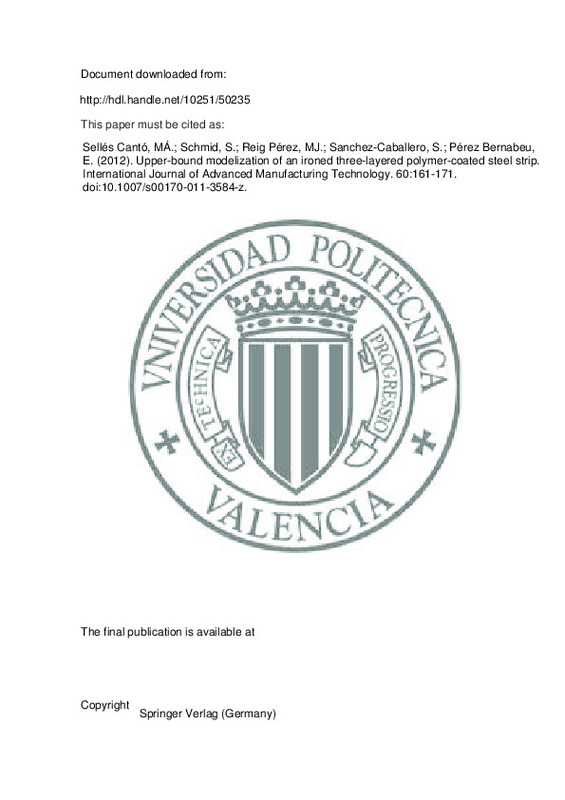Sellés MA, Schmid SR, Seguí VJ (2008) Ironability of a three-layered polymer coated steel. Part 1: experimental investigation. J Mater Process Technol 202:7–14
Jaworski JA, Schmid SR (1999) Survivability of laminated polymer lubricant films in ironing. Tribol Trans 1:32–38
Jaworski JA, Schmid SR, Wang JE (1999) An experimental investigation of the survivability and friction characteristics of tin-coated and polymer-laminated steels. J Manuf Sci Eng 121:232–237
[+]
Sellés MA, Schmid SR, Seguí VJ (2008) Ironability of a three-layered polymer coated steel. Part 1: experimental investigation. J Mater Process Technol 202:7–14
Jaworski JA, Schmid SR (1999) Survivability of laminated polymer lubricant films in ironing. Tribol Trans 1:32–38
Jaworski JA, Schmid SR, Wang JE (1999) An experimental investigation of the survivability and friction characteristics of tin-coated and polymer-laminated steels. J Manuf Sci Eng 121:232–237
Campion D (1980) Deep drawing and ironing—theory and practise. Sheet Met Ind 57:111–119
Chang D-F (1998) An analytical model of the ironing process including redundant work effect. J Mater Process Technol 75:253–258
Huang YM, Lu YH, Chan JW (1991) An elasto-plastic finite element and experimental study of the ironing process. J Mater Process Technol 26:53–80
Teodosiu C, Daniel D, Cao HL, Duval JL (1995) Modelling and simulation of the can-making process using solid finite elements. J Mater Process Technol 50:133–143
Zhan ZR, Wang CW (1995) Numerical simulations for extrusion and ironing and die-angle optimization. J Mater Process Technol 55:48–52
Van den Bosch MJ, Schreurs PJG, Geersa MGD (2009) On the prediction of delamination during deep-drawing of polymer coated metal sheet. J Mater Process Technol 209:297–302
Schünemann M, Ahmetoglu M, Altan T (1996) Prediction of process conditions in drawing and ironing of cans. J Mater Process Technol 59:1–9
Van der Aa MAH, Schreurs PJG, Baaijens FPT (1998) Modelling of the wall ironing process of polymer coated sheet metal. In: Proceedings of fourth world congress on computational mechanics
Nilsson A, Legge D (1999) Process development of aluminium ironing using finite element analysis. Model Simulat Mater Sci Eng 7:1005–1011
Kampus Z, Nardin B (2002) Improving workability in ironing. J Mater Process Technol 130–131:64–68
Wang Z, Dohda K, Jeong Y (2001) FEM simulation of surface smoothing in the ironing process. J Mater Process Technol 113:705–709
Deneuville P, Lecot R (1994) The study of friction in ironing process by physical and numerical modelling. J Mater Process Technol 45:625–630
Kim H-K, Hong SK (2007) FEM-based optimum design of multi-stage deep drawing process of molybdenum sheet. J Mater Process Technol 184:354–362
Adamovic D, Mandic V, Jurkovic Z, Grizelj B, Stefanovic M, Marinkovic T, Aleksandrovic S (2010) An experimental modelling and numerical FE analysis of steel-strip ironing process. Teh Vjesn 17:435–444
Kotani Y, Watanabe A, Nishiumura K, Watari H (2010) Numerical simulation and evaluation of local thickness increment in ironing by finite element method. Adv Mat Res 97–100:404–407
Hosford W, Caddell R (2007) Metal forming: mechanics and metallurgy, 3rd edn. Cambridge University Press, Cambridge
Hosford WF (2008) Mechanical behavior of materials, vol 1. Cambridge University Press, Cambridge
Rowe GW (1972) Conformado de los metales, 1st edn. Ediciones Urmo, Bilbao
Kalpakjian S (1997) Manufacturing processes for engineering materials, 3rd edn. Wesley, Menlo Park
Tresca H (1878) On further application of the flow of solids. Proc Inst Mech Eng 30:301
Press WH, Teukolsky S, Vetterling W, Flannery BP (2002) Numerical recipes in C+ +, vol 2. Cambridge University Press, Cambridge
Challen JM, Mclean LJ, Oxley LB (1884) Plastic deformation of a metal surface in sliding contact with a hard wedge: its relation to friction and wear. Proc R Soc Lond 394(1806):161–181
Wilson WRD, Halliday K (1977) An inlet zone analysis for the lubrication of a drawing process by a rigid-plastic solid. Wear 42:135–148
[-]







![[Cerrado]](/themes/UPV/images/candado.png)


